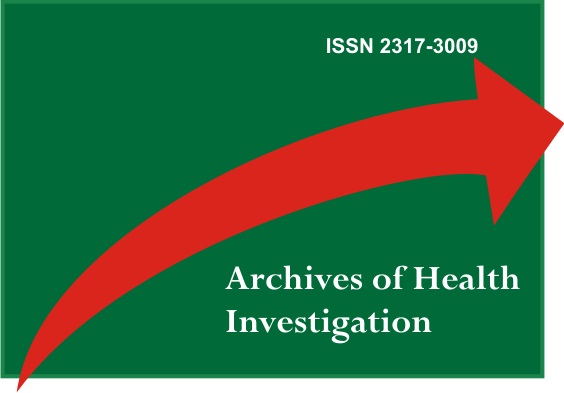Estado da arte da Inteligência Artifical (IA) na radiologia odontológica: revisão sistemática
DOI:
https://doi.org/10.21270/archi.v10i7.5069Palavras-chave:
Inteligência Artificial, Aprendizagem, Aprendizado de Máquina, RadiologiaResumo
Introdução: Inteligência artificial (IA) é a capacidade de imitar a função do cérebro. É uma tecnologia que utiliza o aprendizado de máquina, rede neurais artificiais e a aprendizagem profunda. Ademais, utilizam de algoritmos aprimorados para “conhecer” recursos de um grande volume de dados da saúde para contribuir na atividade clínica, proporcionando um resultado mais rápido, preciso, reduzindo assim os erros de diagnóstico. Objetivo: O objetivo desta revisão sistemática é discorrer sobre o estado da arte na inteligência artificial na Radiologia Odontológica. Material e método: Na busca de evidências foram consultadas as bases de dados MEDLINE, PubMed, BBO, LILACS, BIREME, Google Acadêmico, e COCHRANE, por meio da estratégia PICOS. Todo o processo de avaliação e seleção foi executado por dois examinadores independentes. Resultados: Foram encontrados 878 artigos, seguindo os critérios de elegibilidade, os títulos e resumos foram analisados e 778 resumos excluídos do estudo, 10 textos completos, e finalmente 10 estudos foram incluídos no trabalho. Conclusão: Concluiu-se que os resultados obtidos ratificam que tanto o aprendizado profundo quanto o aprendizado de máquina e rede neurais artificiais são um campo precursor que mostram resultados animadores, principalmente pelo relevante auxilio prestado ao profissional inexperiente e por proporcionar um diagnóstico mais preciso e rápido. A inteligência artificial associada a radiologia odontológica evidencia a otimização do tempo, precisão diagnóstica, elaboração de tratamentos personalizados e previsão da eficácia no tratamento, características estas que contribuem para melhor qualidade no atendimento e, portanto, mais uma ferramenta de auxílio para os profissionais da radiologia odontológica.
Downloads
Referências
Yaji A, Prasad S, Pai A. Artificial Intelligence in Dento-Maxillofacial Radiology. Act Scient Dent Scienc. 2018;3(1):116-18.
Khanna SS, Dhaimade PA. Artificial Intelligence: Transforming Dentistry Today. J Ind Basic Ap Med Research. 2017;6(3):161-64.
Schwab KA Quarta revolução industrial. Barcelona: Debate; 2016.
Lobo LC. Artificial Intelligence, the Future of Medicine and Medical Education. Rev Bras Educ Med. 2018;42(3):3-8.
Liew C. The future of radiology augmented with Artificial Intelligence: A strategy for success. Eur J Radiol. 2018;102:152-56.
Paiva OA, Prevedello LM. O potencial impacto da inteligência artificial na radiologia. Radiol Bras. 2017;50(5):V-VI.
Azevedo-Marques PM, Mencattini A, Salmeri R, et al. Medical image analysis and informatics. Boca Raton, FL: CRC Press; 2017.
Doi K. Computer-aided diagnosis in medical imaging: historical review, current status and future potential. Comput Med Imaging Graph. 2007;31:198-211
Aerts HJWL. The potential of radiomic-based phenotyping in precision medicine: a review. JAMA Oncol. 2016;2:1636-42.
Keek SA, Leijenaar RT, Jochems A, et. al. A review on radiomics and the future of theranostics for patient selection in precision medicine. Br J Radiol. 2018;91:20170926
Kalappanavar A, Sneha S, Annigeri RG. Artificial intelligence: A dentist’s perspective - J Med RadiolPathol Surg. 2018;5:2-4.
Kise Y, Ikeda H, Fujii T, Fukuda M, Ariji Y, Fujita H, Katsumata A, Ariji E. Preliminary study on the application of deep learning system to diagnosis of Sjögren's syndrome on CT images. Dentomaxillofac Radiol. 2019;48(6):20190019.
Murata M, Ariji Y, Ohashi Y, Kawai T, Fukuda M, Funakoshi T, Kise Y, Nozawa M, Katsumata A, Fujita H, Ariji E. Deep-learning classification using convolutional neural network for evaluation of maxillary sinusitis on panoramic radiography. Oral Radiol. 2019;35(3):301-7.
Hiraiwa T, Ariji Y, Fukuda M, Kise Y, Nakata K, Katsumata A, Fujita H, Ariji E. A deep-learning artificial intelligence system for assessment of root morphology of the mandibular first molar on panoramic radiography. Dentomaxillofac Radiol. 2019;48(3):20180218.
Lee JH, Kim DH, Jeong SN, Choi SH. Detection and diagnosis of dental caries using a deep learning-based convolutional neural network algorithm. J Dent. 2018: 10.1016/j.jdent. 2018.07.015.
Kim, D.W., Lee, S., Kwon, S, Nam W, Cha IH, Kim HJ. Deep learning-based survival prediction of oral cancer patients. Sci Rep. 2019;9:6994.
Shankarapillai R, Mathur lk, Nair MA, Rai N, Mathur A. Periodontitis Risk Assessment using two artificial Neural Networks-A Pilot Study. Int J Dent Clin. 2010:2(4):36-40
De Tobel J, Radesh P, Vandermeulen D, Thevissen PW. An automated technique to stage lower third molar development on panoramic radiographs for age estimation: a pilot study. J Forensic Odontostomatol. 2017;35(2):42-54.
Jung SK, Kim TW. New approach for the diagnosis of extractions with neural network machine learning. Am J Orthod Dentofacial Orthop. 2016;149(1):127-33.
Jha S, Topol EJ. Information and Artificial Intelligence. Journal of the American College of Radiology.2018;15(3):509-11.
Majumdar B, Sarode SC, Sarode GS, Patil S. Technology: Artificial intelligence. J Brit Dent. 2018;224(12):916.
Marques JR. Inteligência Artificial: vantagens e desvantagens quanto ao seu uso. Portal IBC2017. [Citado 2019 Fev 4]. Disponível em : https://www.ibccoaching.com.br/portal/artigos/inteligencia-artificial-vantagens-desvantagens-quanto-seu-uso/
Khanna SS, Dhaimade P.A. Artificial Intelligence: Transforming Dentistry Today. J Ind Basic Ap Med Research. 2017;6(3):161-64.


